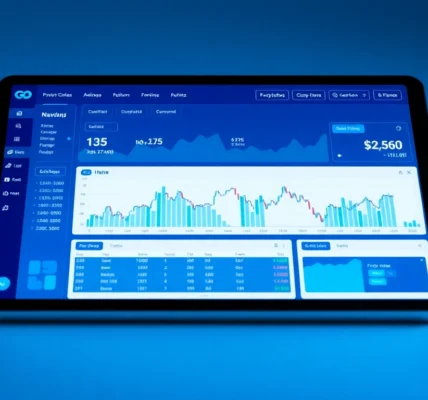Understanding the Current Landscape of Stocks and Shares Reporting
The global financial ecosystem is constantly shifting, driven by a complex interplay of economic indicators, geopolitical developments, technological innovations, and investor sentiment. Central to navigating this dynamic environment is effective Stocks and Shares Reporting. This process not only provides transparency but also serves as the foundation for informed investment decision-making. A comprehensive understanding of how stocks and shares reports are generated, analyzed, and utilized is essential for investors seeking to stay ahead in an increasingly volatile market.
Key Principles Behind Stocks and Shares Reporting
Fundamental Components of Stock Reports
Stocks and shares reports typically encompass a variety of data points, including company financials—such as income statements, balance sheets, and cash flow statements—market performance metrics, sector comparisons, and macroeconomic indicators. Accurate reporting hinges on adhering to stringent accounting standards like IFRS or GAAP, ensuring consistency and comparability across reports. These principles uphold the integrity of the data, allowing investors to evaluate companies objectively.
The Role of Accuracy and Timeliness
In fast-paced markets, timely and precise reporting is critical. Delays or inaccuracies can mislead investors, causing misguided trades or missed opportunities. With the rise of digital platforms, real-time data feeds and automated reporting systems now play a vital role, reducing latency and minimizing human error.
Importance of Transparent Methodology
Transparency in reporting methodology—how data is collected, analyzed, and presented—builds investor trust. When companies and analysts clearly communicate their assumptions, valuation models, and data sources, it enhances the report’s credibility and facilitates better investment decisions.
The Impact of Accurate Reporting on Investment Decisions
Enabling Informed Investment Choices
Reliable reports allow investors to assess a company’s intrinsic value, growth prospects, and risk factors. For instance, a detailed financial analysis could reveal whether a company’s stock is undervalued or overvalued relative to its sector peers. This helps in constructing diversified portfolios aligned with an investor’s risk appetite and return expectations.
Facilitating Strategic Entry and Exit Points
Timely stock reports lay the groundwork for strategic trading, such as implementing entry points during dips or exit strategies during peaks. Advanced traders utilize technical reports, including trend analyses and pattern recognition, to optimize their trades based on reported data.
Supporting Regulatory Compliance and Investor Protection
Accurate and consistent reporting also ensures compliance with regulatory standards set by bodies such as the FCA or SEC, helping prevent fraudulent practices. Transparency safeguards market integrity and protects retail investors from manipulative schemes.
Market Transparency and Confidence Through Robust Reporting
Building Trust in Financial Markets
Transparent reports mitigate information asymmetry, fostering trust among market participants. When investors believe that disclosures are fair and comprehensive, they are more willing to allocate capital, enhancing liquidity and stability.
Enhancing Market Efficiency
Efficient markets rely on the rapid assimilation of available information. Well-structured reports expedite this process, enabling price discovery that accurately reflects underlying fundamentals. The recent integration of AI and data analytics has further sharpened this efficiency, providing granular insights in seconds rather than days.
Addressing Challenges of Data Manipulation
Despite advances, challenges such as data manipulation or selective disclosure persist. Regulatory frameworks and independent auditing act as deterrents, ensuring that reports remain truthful and comprehensive.
Analyzing Market Trends Using Stocks and Shares Reports
Identifying Bullish and Bearish Signals
Market trend analysis involves deciphering signals embedded within reports. For example, consistent revenue increases, margin expansion, and positive cash flows suggest bullish momentum, while declining profits and deteriorating liquidity indicate bearish phases.
Using Data Analytics for Forecasting
Modern forecasting models leverage historical data, machine learning algorithms, and macroeconomic indicators to predict market movements. For example, if reports show rising institutional holdings coupled with upward earnings revisions, analysts might forecast an upcoming rally.
Case Studies of Predictive Success
One notable case involved the 2020 tech surge, where detailed quarterly reports revealed strong cash reserves and growth in cloud segments, signaling sustained bullish momentum. Similarly, lithium-related stocks surged following positive supply reports—highlighting how data-driven insights can anticipate market shifts.
Advanced Techniques in Stocks and Shares Reporting
Integrating Real-Time Data and Analytics Tools
Real-time dashboards and analytics platforms enable investors to monitor key metrics continuously. Tools like Bloomberg Terminal or Thomson Reuters Eikon aggregate news, financial data, and technical indicators, offering a comprehensive view essential for timely decision-making.
Leveraging AI and Automation
Artificial intelligence streamlines report generation and analysis. Machine learning models can detect patterns, predict trends, and even generate customized reports tailored to individual investor profiles. Meta’s recent integration of AI in internal tools exemplifies this trend, aiming to enhance decision support systems.
Customizing Reports for Diverse Investor Profiles
Different investors have distinct priorities—value investors focus on earnings and ratios, while traders may prefer technical signals. Advanced reporting platforms can be customized accordingly, ensuring relevance and actionable insights for each user.
Overcoming Challenges in Stocks and Shares Reporting
Ensuring Data Accuracy Amid Market Volatility
Volatility can distort figures temporarily. Implementing robust data validation processes, cross-verifying sources, and using smoothing techniques help maintain accuracy during turbulent periods.
Handling Information Overload
With vast volumes of data, filtering relevant insights is crucial. Employing AI-powered filters, alerts, and summary dashboards enables investors to focus on the most impactful information without being overwhelmed.
Adapting to Regulatory Changes
Regulators continually update disclosure requirements. Staying compliant requires ongoing training, adaptable reporting frameworks, and proactive updates to reporting practices, ensuring transparency without legal vulnerabilities.
Future Trends in Stocks and Shares Reporting for Investors
Emerging Technologies for Enhanced Reporting
Blockchain-based reports promise immutable records, increasing trust. AI-driven predictive analytics will offer real-time stock forecasts with higher accuracy, revolutionizing how investors interpret data.
The Rise of Interactive and Mobile Reporting Platforms
As mobile consumption dominates, interactive dashboards and app-based reports enable investors to access tailored insights on-the-go. These platforms foster greater engagement and real-time responsiveness.
Strategies to Stay Ahead in Reporting Innovation
Proactive adoption of AI tools, continuous education on regulatory developments, and leveraging data partnerships will position investors and firms to thrive amid technological shifts. Collaborations like Meta exploring partnership opportunities are indicative of this evolving landscape.




